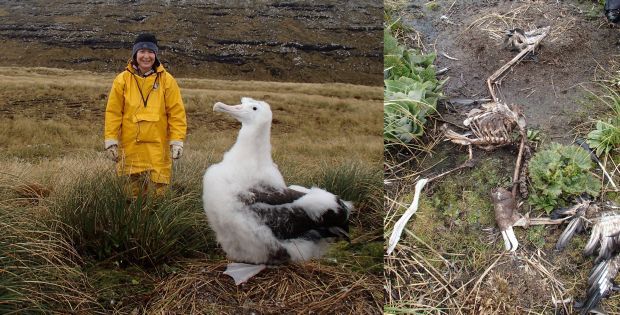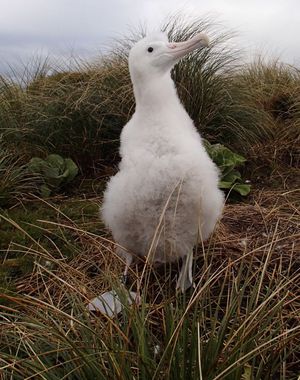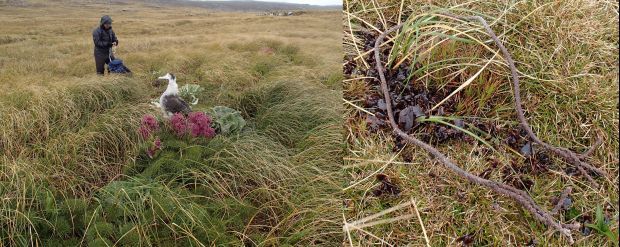
ABOVE Alison Ballance with a Gibson's wandering albatross chick that is fully grown but yet to develop all its adult feathers, and another chick that died just before fledging. BELOW LEFT A Gibson's wandering albatross chick that is still covered in down (images: A. Ballance)
 They might have the longest wingspan of any seabird in the world, but as two researchers have discovered during a 20-year study on remote subantarctic Adams and Antipodes islands, wandering albatrosses are surprisingly sensitive to changes taking place in the world’s oceans. Although an initial decline due to interactions with longline fisheries has been largely solved, both albatross populations underwent a significant decline in the mid-2000s which disproportionately affected females, and as a result there is now a severe imbalance in the sex ratio of breeding adults, chick production is much lower than formerly, and overall population size is about half of what is was in the early 1990s.
They might have the longest wingspan of any seabird in the world, but as two researchers have discovered during a 20-year study on remote subantarctic Adams and Antipodes islands, wandering albatrosses are surprisingly sensitive to changes taking place in the world’s oceans. Although an initial decline due to interactions with longline fisheries has been largely solved, both albatross populations underwent a significant decline in the mid-2000s which disproportionately affected females, and as a result there is now a severe imbalance in the sex ratio of breeding adults, chick production is much lower than formerly, and overall population size is about half of what is was in the early 1990s.
When Alison Ballance was in the Auckland Islands at the end of last year on an expedition to count yellow-eyed penguins she got a rare opportunity to join the Department of Conservation’s Jo Hiscock as she carried out some field work in the Gibson’s wandering albatross study area on the south side of Adams Island.
More recently, Alison caught up with long-time albatross scientists Kath Walker and Graeme Elliott to find out more about the population trends of Gibson’s wandering albatrosses on Adams Island and Antipodes wandering albatrosses on Antipodes Island. Here is a report on their most recent research season 2012-13. You can listen here to an earlier interview with Kath and Graeme recorded on Adams Island in 2009.
Jo Hiscock in the wandering albatross study area on the south side of Adams Island (megaherbs often grow near albatross nests in response to the nutrient flush), and squid beaks and a piece of rope that have been fed to a chick and then regurgitated (images: A. Ballance)


